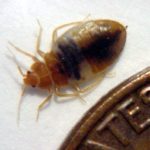Identifying bed bugs
The common bed bug (Cimex lectularius) is the species most adapted to living with humans. Bed bugs are parasites that feed on humans. Often mistaken for ticks or small cockroaches, adult bed bugs are reddish-brown or mahogany in color and flat. Female bed bugs have a round body, while males are more oval shaped. Though their anatomy includes primitive wings, bed bugs cannot fly. They grow to about 1/4″ long and 1/8″ wide, or about the size of an apple seed.
Contact Modern Pest Services for a thorough Bed Bug inspection and a FREE quote today! Or call 1-800-323-7378
Bed bug “hitchhikers”
Bed bugs do not fly or jump but can move rapidly over floors, walls, ceilings and other surfaces. Well known for their hitchhiking capabilities, bed bugs are brought into an environment from the outside and are often unknowingly transported and relocated as people and personal items travel.
Bed bugs can easily hitch rides on items such as:
- luggage
- backpacks
- briefcases
- clothing
- shoes
- handbags
- used furniture (chairs, couches, dressers, beds)
Hiding spots for bed bugs:
- seams of mattresses and box springs
- furniture such as bed frames, headboards, nightstands, and dressers
- items such as lamps, clocks, telephones, etc.
- flooring, carpets, baseboards, and wood trim
- curtains and upholstery
- wallpaper and picture frames
- electrical switches and outlets
- clothing, clutter or objects near a bed
- Sofas or chairs used for sleeping or extended periods of rest
Habitat for bed bugs
Bed bugs are not the result of someone’s social status or cleanliness, so no one is immune to getting them. Bed bugs are found anywhere people live and congregate, and infestations have occurred in many different types of facilities, including:
- apartments/condos
- single-family homes
- hotels/motels
- schools/college dorms
- homeless shelters
- healthcare facilities
- retail stores/businesses
- public venues (e.g. movie theaters)
- various modes of transportation
Bed bug feeding
Bed bugs do not attach to hair or skin or live on people like lice, but generally come out at night to prey on their hosts and feed on any skin exposed while sleeping. Humans are the preferred host, but they will feed on other hosts, such as poultry, mice, rats, canaries, dogs, and cats.
Bed bugs feed by piercing the skin with an elongated beak through which they withdraw blood. Their saliva contains a numbing chemical that prevents the host from feeling the bite, and they also administer an anti-coagulant when they bite, allowing the blood to flow more freely. Bed bugs feed from 3–10 minutes and consume up to 3 times their body weight in a single feeding. Immediately after feeding, they retreat to their hiding spot to digest their meal. Bed bugs generally feed every two weeks and can live up to a year without feeding.
RELATED Blog: Are there Health Risks to Bed Bugs?
Identifying bed bug bites
A single bed bug can bite a dozen or more times in a night. Symptoms of being bitten vary with each individual, but many develop an itchy red welt or localized swelling. 50% of bite victims have little or no reaction to bed bugs, some reactions are delayed, and some bites can cause allergic reactions or rashes. Though bed bugs do not transmit disease, they can take a real emotional toll on their victims, causing discomfort, sleeplessness, anxiety, stress, and embarrassment.

